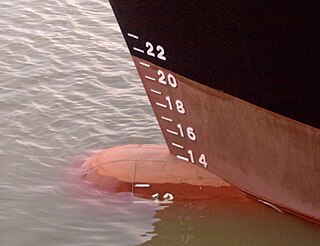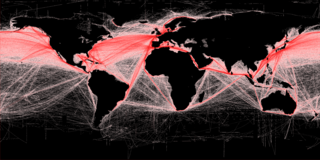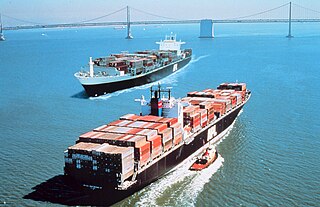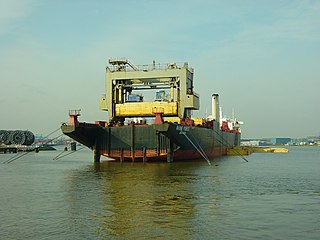The modern terms short sea shipping,marine highway and motorways of the sea refer to the historical terms coastal trade, coastal shipping, coasting trade and coastwise trade, which encompass the movement of cargo and passengers mainly by sea along a coast, without crossing an ocean. [1] 'Deep-sea shipping', 'intercontinental shipping' or 'ocean shipping' refers to maritime traffic that crosses oceans. While 'short-sea shipping' is the term used in Europe, the United States also has used the term, 'marine highway'. [2]
Motorways of the Sea are a concept in the transport policy of the European Union, stressing the importance of sea transport. The main aim of these Motorways of the Sea is to improve port communications with peripheral regions of the European continent and thus strengthen the networks between the EU candidate countries and those countries already part of the European Union.
Contents
Historically, many developed English-speaking countries used the British term 'coasting trade' or 'coastwise trade', which is still used. [2] The coastwise slave trade referred to the domestic slave trade in the United States that shipped slaves by water from the Upper South to major markets, especially New Orleans.
The United States maintained this term from its colonial era and began regulating the coastwise trade as early as 1793, with the Congressional passage of "An act for enrolling and licensing ships and vessels to be employed in the coasting trade and fisheries, and for regulating the same", which passed on 18 February that year. [3] Over the years, it has been codified as 46 U.S.C., Coastwise Trade. [4]
Title 46 of the United States Code outlines the role of shipping in the United States Code.
Some short sea ship vessels are small enough to travel inland on inland waterways. Short sea shipping includes the movements of wet and dry bulk cargoes, containers and passengers around the coast (say from Lisbon to Rotterdam or from New Orleans to Philadelphia). Typical ship sizes range from 1,000 DWT (tonnes deadweight – i.e. the amount of cargo they carry) to 15,000 DWT with drafts ranging from around 3 to 6 m (10 to 20 ft). Typical cargoes include grain, fertilisers, steel, coal, salt, stone, scrap and minerals (all in bulk), oil products (such as diesel oil, kerosene, aviation spirit – all in bulk), containers and passengers. Short sea shipping should not be mistaken with inland navigation.

Deadweight tonnage or tons deadweight (TDW) is a measure of how much weight a ship can carry, not its weight, empty or in any degree of load. DWT is the sum of the weights of cargo, fuel, fresh water, ballast water, provisions, passengers, and crew.

The draft or draught of a ship's hull is the vertical distance between the waterline and the bottom of the hull (keel), with the thickness of the hull included; in the case of not being included the draft outline would be obtained. Draft determines the minimum depth of water a ship or boat can safely navigate. The draft can also be used to determine the weight of the cargo on board by calculating the total displacement of water and then using Archimedes' principle. A table made by the shipyard shows the water displacement for each draft. The density of the water and the content of the ship's bunkers has to be taken into account. The closely related term "trim" is defined as the difference between the forward and aft drafts.
In Europe, short sea shipping is at the forefront of the European Union's transportation policy. It currently accounts for roughly 40% of all freight moved in Europe. In the US, short sea shipping has yet to be used to the extent it is in Europe, but there is some development. The main advantages promoted for this type of shipping are alleviation of congestion, decrease of air pollution, and overall cost savings to the shipper and a government. Shipping goods by ship (one 4,000 DWT vessel is equivalent to between 100–200 trucks) is far more efficient and cost-effective than road transport (though the goods, if bound inland, have to be transferred and delivered by truck) and is much less prone to theft and damage.

The European Union (EU) is a political and economic union of 28 member states that are located primarily in Europe. It has an area of 4,475,757 km2 (1,728,099 sq mi) and an estimated population of about 513 million. The EU has developed an internal single market through a standardised system of laws that apply in all member states in those matters, and only those matters, where members have agreed to act as one. EU policies aim to ensure the free movement of people, goods, services and capital within the internal market, enact legislation in justice and home affairs and maintain common policies on trade, agriculture, fisheries and regional development. For travel within the Schengen Area, passport controls have been abolished. A monetary union was established in 1999 and came into full force in 2002 and is composed of 19 EU member states which use the euro currency.
Roughly 40% of all freight moved in Europe is classified as Short Sea Shipping, but the greater percentage of this cargo moves through Europe’s heartland on rivers and not oceans. In the past decade the term Short Sea Shipping has evolved in a broader sense to include point-to-point cargo movements on inland waterways as well as inland to ocean ports for transhipment over oceans.



















